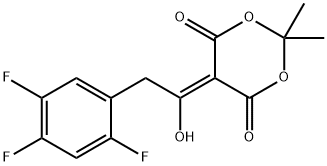5-1-hydroxy-2-(2,4,5-trifluorophenyl)ethylidene-2,2-dimethyl-1,3-dioxane-4,6-dione
- CAS NO.:764667-64-3
- Empirical Formula: C14H11F3O5
- Molecular Weight: 316.23
- MDL number: MFCD12407134
- SAFETY DATA SHEET (SDS)
- Update Date: 2023-05-31 14:19:17

What is 5-1-hydroxy-2-(2,4,5-trifluorophenyl)ethylidene-2,2-dimethyl-1,3-dioxane-4,6-dione?
Chemical properties
White to Off-white Solid.
The Uses of 5-1-hydroxy-2-(2,4,5-trifluorophenyl)ethylidene-2,2-dimethyl-1,3-dioxane-4,6-dione
5-[1-Hydroxy-2-(2,4,5-trifluorophenyl)ethylidene]-2,2-dimethyl-1,3-dioxane-4,6-dione is an impurity of the DPP-IV inhibitor Sitagliptin (S491000).
What are the applications of Application
5-[1-Hydroxy-2-(2,4,5-trifluorophenyl)ethylidene] is an intermediate for the synthesis of sitagliptin. Sitagliptin is a new type of anti-type II diabetes drug approved by the FDA and the first dipeptidyl peptidase-IV inhibitor drug for the treatment of type II diabetes.
Properties of 5-1-hydroxy-2-(2,4,5-trifluorophenyl)ethylidene-2,2-dimethyl-1,3-dioxane-4,6-dione
| Melting point: | 117 °C (decomp) |
| Boiling point: | 489.0±45.0 °C(Predicted) |
| Density | 1.462±0.06 g/cm3(Predicted) |
| storage temp. | under inert gas (nitrogen or Argon) at 2-8°C |
| solubility | Chloroform (Slightly), Ethyl Acetate (Slightly), Methanol (Slightly) |
| form | Solid |
| pka | 4.50±1.00(Predicted) |
| color | White to Off-White |
Safety information for 5-1-hydroxy-2-(2,4,5-trifluorophenyl)ethylidene-2,2-dimethyl-1,3-dioxane-4,6-dione
| Signal word | Warning |
| Pictogram(s) |
 Exclamation Mark Irritant GHS07 |
| GHS Hazard Statements |
H302:Acute toxicity,oral H315:Skin corrosion/irritation H319:Serious eye damage/eye irritation H335:Specific target organ toxicity, single exposure;Respiratory tract irritation |
| Precautionary Statement Codes |
P261:Avoid breathing dust/fume/gas/mist/vapours/spray. P305+P351+P338:IF IN EYES: Rinse cautiously with water for several minutes. Remove contact lenses, if present and easy to do. Continuerinsing. |
Computed Descriptors for 5-1-hydroxy-2-(2,4,5-trifluorophenyl)ethylidene-2,2-dimethyl-1,3-dioxane-4,6-dione
5-1-hydroxy-2-(2,4,5-trifluorophenyl)ethylidene-2,2-dimethyl-1,3-dioxane-4,6-dione manufacturer
New Products
(S)-3-Aminobutanenitrile hydrochloride 4-Methylphenylacetic acid N-Boc-D-alaninol N-BOC-D/L-ALANINOL Tert-butyl bis(2-chloroethyl)carbamate 3-Morpholino-1-(4-nitrophenyl)-5,6-dihydropyridin- 2(1H)-one Furan-2,5-Dicarboxylic Acid Tropic acid 1-Bromo-3,5-Di-Tert-Butylbenzene S-2-CHLORO PROPIONIC ACID ETHYL ISOCYANOACETATE 2-Bromo-1,3-Bis(Dimethylamino)Trimethinium Hexafluorophosphate 4-IODO BENZOIC ACID 3-NITRO-2-METHYL ANILINE 1-(2,4-DICHLOROPHENYL) ETHANAMINE (2-Hydroxyphenyl)acetonitrile 4-Bromopyrazole 2-(Cyanocyclohexyl)acetic acid 4-methoxy-3,5-dinitropyridine 1-(4-(aminomethyl)benzyl)urea hydrochloride 2-aminopropyl benzoate hydrochloride diethyl 2-(2-((tertbutoxycarbonyl)amino) ethyl)malonate tert-butyl 4- (ureidomethyl)benzylcarbamate Ethyl-2-chloro((4-methoxyphenyl)hydrazono)acetateRelated products of tetrahydrofuran


![Benzenebutanoicacid,b-[[(1,1-diMethylethoxy)carbonyl]aMino]-2,4,5-trifluoro-,Methylester,(bR)-](https://img.chemicalbook.in/CAS/20150408/GIF/881995-73-9.gif)



![2-CHLOROMETHYL-5-TRIFLUOROMETHYL-[1,3,4]OXADIAZOLE](https://img.chemicalbook.in/CAS/GIF/723286-98-4.gif)

You may like
-
 764667-64-3 5-(1-hydroxy-2-(2,4,5-trifluorophenyl)ethylidene)-2,2-dimethyl-1,3-dioxane-4,6-dione 98%View Details
764667-64-3 5-(1-hydroxy-2-(2,4,5-trifluorophenyl)ethylidene)-2,2-dimethyl-1,3-dioxane-4,6-dione 98%View Details
764667-64-3 -
 764667-64-3 98%View Details
764667-64-3 98%View Details
764667-64-3 -
 1975-50-4 98%View Details
1975-50-4 98%View Details
1975-50-4 -
 2-HYDROXY BENZYL ALCOHOL 98%View Details
2-HYDROXY BENZYL ALCOHOL 98%View Details
90-01-7 -
 2-Chloro-1,3-Bis(Dimethylamino)Trimethinium Hexafluorophosphate 221615-75-4 98%View Details
2-Chloro-1,3-Bis(Dimethylamino)Trimethinium Hexafluorophosphate 221615-75-4 98%View Details
221615-75-4 -
 61397-56-6 CIS BROMO BENZOATE 98%View Details
61397-56-6 CIS BROMO BENZOATE 98%View Details
61397-56-6 -
 14714-50-2 (2-Hydroxyphenyl)acetonitrile 98+View Details
14714-50-2 (2-Hydroxyphenyl)acetonitrile 98+View Details
14714-50-2 -
 118753-70-1 98+View Details
118753-70-1 98+View Details
118753-70-1
Statement: All products displayed on this website are only used for non medical purposes such as industrial applications or scientific research, and cannot be used for clinical diagnosis or treatment of humans or animals. They are not medicinal or edible.